Join More Than 50,000+ Subscribers and get latest camera news and rumors
NEW CAMERA VIDEOS ON YOUTUBE
|
By admin, on October 29th, 2015
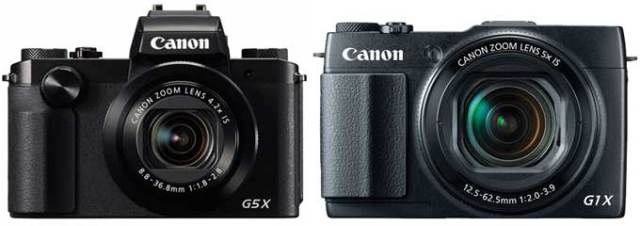
Will Canon G5x Mark II can be a good competitor of G1 X Mark II. It will be cleared with this details comparison. Let’s see.
Major Difference
Canon PowerShot G5 X vs. Canon PowerShot G1 X Mark II Specification Comparison Table.
| Features / Models |
Canon G5 X |
Canon G1 X Mark II |
| Megapixel |
20.2 megapixels |
12.8 megapixels |
| Sensor size / type |
1″ (13.2 x 8.8 mm) |
1.5″ (18.7 x 14 mm) |
| Low –Pass filter |
Yes |
Yes |
| Optical zoom |
4.2x |
5x |
| Aperture Range |
F1.8 – F2.8 |
F2.0 – F3.9 |
| Macro |
5cm |
5cm |
| Image stabilization |
Optical (hybrid) |
Optical (hybrid) |
| AF System |
Contrast Detect (sensor) |
Contrast Detect (sensor) |
| ISO |
125-12800 |
100-12800 |
| Shutter Min/Max |
30 sec 1/2000 sec |
60 sec 1/4000 sec |
| Top Continuous Shooting Speed |
5.9fps |
5fps |
| Video |
1920 x 1080 (60p, 30p) |
1920 x 1080 (30p) |
| Display |
3.0″ LCD Rear Touch Screen Swivel (1,040,000 pixels) |
3.0″ LCD Rear Touch Screen Tilt (1,040,000 pixels) |
| Viewfinder |
EVF 100% |
No |
| Hot-shoe |
Yes |
Yes |
| Battery Life (CIPA) |
210 short |
240 shots |
| Environmentally sealed |
No |
No |
| Wireless connectivity |
Built-In with NFC |
Built-In with NFC |
| Dimensions |
112 x 76 x 44 mm |
116 x 74 x 66 mm |
| Weight |
353g |
553g |
Sensors:- Canon G5X has resolutions of 20.2MP where as Canon G1 X Mark II has the less resolution of 12.8MP.
Canon G5 X has used the high-sensitivity Sony-made 1″ sensor and the same sensor sported inside the RX 100 M III, while Canon G1 X Mark II has utilized a larger Canon made CMOS sensor of 1.5”. keep in mind that Canon G1X mark II sensor is made by Canon.
The 1″ sensor of G5X combined with DIGIC 6 image processor that supports the camera to perform better in low-light conditions with reduced image noise. While the large 1.5″ CMOS sensor and DIGIC 6 image processor helps the Canon G1 X Mark II produces noiseless images during the low-light shooting.
Here, Canon G5X has small 1″ sensor and more resolution compare to G1X Mark II but due to the implementation of advanced technology and BSI CMOS Sensor, the G5X manages to gain the similar ISO range comparative to G5X. Both the cameras maintained the similar expanded ISO of 12800. Canon G5X captures 20.2MP files @ 5.9fps while Canon G1 X Mark II captures 12.8MP files @ 5fps.
Low pass filter:- Both the cameras have Low pass filter which eliminates the problem of moiré by blurring what actually reaches the sensor.
Optical Zoom:- Canon G1 X Mark II has more optical zoom of 5x compare to Canon G5 X, which has optical zoom of 4.2x. So due to large optical zoom of Canon G1 X Mark II, it is beneficial for those users who want to capture the far subjects.
Aperture Range:- Canon G5X has the bright aperture range of F1.8-2.8 while Canon G1 X Mark II has the aperture of F2.0-3.9. However the Canon G1X Mark II has large 1.5 inch sensor that will sure give you more depth of field compared to G5X camera by having 1″ sensor.
Image Stabilization:- Both the camera has advance HS system inside it that helps you to compensate the camera shake all the way.
AF System:– Both the cameras G5 X and Canon G1 X Mark II have similar contrast detect AF system, however by the nature of lens and the size of sensor the G5X will do bit faster AF than the Canon G5X camera.
ISO:– Canon G5X has the ISO range of 125-12800 while Canon G1 X Mark II has the ISO of 100-12800. Despite of mimicking the ISO range of Canon G1X Mark II we don’t expect the Canon G5X will give same high ISO out-put as of G1X Mark II. Not only low-light sensor the camera will also give more dynamic range compared to G5X.
Shutter speed:- As we know the camera with more shutter speed gains more capacity in capturing the fast action subjects. so, looking at specification comparison Canon G1 X Mark II has better shutter speed compare to G5 X. Not only fast shutter speed the G5 X has better continuous shooting speed of 5.9fps compare to Canon G1 X Mark II.
Videos:- Both have common video specification. Canon G1 X Mark II supports Full HD 1080p movie recording at 30 fps in the Internet-friendly MP4 format while G5X offers full HD 1080p video recording at multiple frame rate including 60, 30, and 24 fps.Hence, G5X offers magnificent and superior images compare to G1 X Mark II.
View finder:- Canon G5 X has EVF viewfinder, which provides 100% frame coverage and also supports the users a better experience of live view image during photography and also allows the users to shoot better images in bright conditions without facing any problems.
But viewfinder is absent in Canon G1 X Mark II.
Verdict: Based on specification review we recommend you to buy Canon G1X Mark II camera that feature large 1.5″ sensor and will give you better image quality compared to Canon G5X camera.
Buy G1X Mark II from Amazon || B&H | — Buy Canon G5X from B&H and Amazon
By admin, on October 26th, 2015
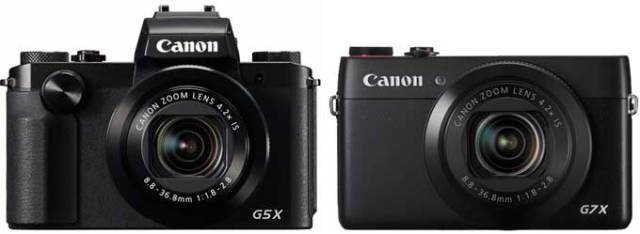 The canon G5X and G7X uses the same 1″ sensor, now let’s find out the best camera for you. The canon G5X and G7X uses the same 1″ sensor, now let’s find out the best camera for you.
Canon G5 X vs. Canon G7 X Specification Comparison Table.
| Features / Models |
Canon G5 X |
Canon G7 X |
| Megapixel |
20.2 megapixels |
20.2 megapixels |
| Sensor size / type |
1″ (13.2 x 8.8 mm) |
1″ (13.2 x 8.8 mm) |
| Low –Pass filter |
Yes |
Yes |
| Optical zoom |
4.2x |
4.2x |
| Aperture Range |
F1.8 – F2.8 |
F1.8 – F2.8 |
| Macro |
5cm |
5cm |
| Image stabilization |
Optical |
Optical |
| AF System |
Contrast Detect (sensor) |
Contrast Detect (sensor) |
| ISO |
125-12800 |
125-12800 |
| Shutter Min/Max |
30 sec 1/2000 sec |
15 sec 1/2000 sec |
| Top Continuous Shooting Speed |
5.9fps |
6.5fps |
| Video |
1920 x 1080 (60p, 30p) |
1920 x 1080 (60p, 30p) |
| Display |
3.0″ LCD Rear Touch Screen Swivel (1,040,000 pixels) |
3.0″ 1,040k-Dot Tilting Touchscreen LCD |
| Viewfinder |
EVF 100% |
No |
| Hot-shoe |
Yes |
No |
| Battery Life (CIPA) |
210 short |
210 shots |
| Environmentally sealed |
No |
No |
| Wireless connectivity |
Built-In with NFC |
Built-In with NFC |
| Dimensions |
112 x 76 x 44 mm |
103 x 60 x 40 mm |
| Weight |
353g |
304g |
As you can see both camera core specification is almost identical.
Both the camera uses
- same sensor
- Same image processor and
- Same Lens
The Canon G5X look similar to Canon G7X expect a Grip and a pentaprism viewfinder type construction. However don’t get confused the Canon added a EVF on th rear side of the camera and a pop-up flash.
Along with the control ring similar to G7X the Canon added a front mode dial button for more customization control.
The large LCD display screen now move all the way you want and you can add external microphone in G5X via mic input.
Verdict: Canon G5X is better than G7X by some marginal features and at the same time we also recommend Canon G16 users to go ahead and finally upgrade their camera with Canon G9X or Canon G1X Mark II.
Buy Canon G5X from B&H and Amazon | | Buy Canon G7X from Amazon | B&H
By Naresh Kumar, on October 26th, 2015
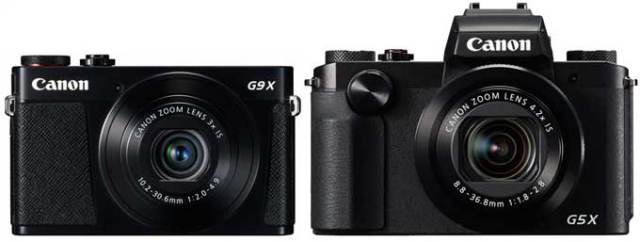 Take a look specification comparison between both the camera, Canon G9X and Canon G5X. Take a look specification comparison between both the camera, Canon G9X and Canon G5X.
Canon PowerShot G9 X vs. Canon PowerShot G5 X Specification Comparison Table.
| Features / Models |
Canon G9 X |
Canon G5 X |
| Megapixel |
20 megapixels |
20.2 megapixels |
| Sensor size / type |
1″ (13.2 x 8.8 mm) |
1″ (13.2 x 8.8 mm) |
| Low –Pass filter |
Yes |
Yes |
| Optical zoom |
3x |
4.2x |
| Aperture Range |
F2.0 – F4.9 |
F1.8 – F2.8 |
| Macro |
5cm |
5cm |
| Image stabilization |
Optical |
Optical |
| AF System |
Contrast Detect (sensor) |
Contrast Detect (sensor) |
| ISO |
125-12800 |
125-12800 |
| Shutter Min/Max |
30 sec 1/2000 sec |
30 sec 1/2000 sec |
| Top Continuous Shooting Speed |
6 fps |
5.9fps |
| Video |
1920 x 1080 (60p, 30p) |
1920 x 1080 (60p, 30p) |
| Display |
3.0″ LCD Rear Touch Screen (1,040,000 pixels) |
3.0″ LCD Rear Touch Screen Swivel (1,040,000 pixels) |
| Viewfinder |
No |
EVF 100% |
| Hot-shoe |
No |
Yes |
| Battery Life (CIPA) |
220 shot |
210 shot |
| Environmentally sealed |
No |
No |
| Wireless connectivity |
Built-In with NFC |
Built-In with NFC |
| Dimensions |
98 x 58 x 31 mm |
112 x 76 x 44 mm |
| Weight |
209g |
353g |
Sensors:- Both Canon G9 X as well as Canon G5 X has almost same resolutions of 20MP and 20.2MP respectively with the same CMOS sensor size of 1”.
The 1” CMOS sensor with DIGIC 6 image processor used inside both the cameras to perform better in low-light conditions with the reduction in noise. The G9 X and G5X have maintained the almost similar ISO of 125-12800. Let’s talk about the resolution vs processor speed — Canon G9 X supports to capture 20MP files @6fps where Canon G5X captures 20.2 files @ 5.9fps. (yep almost same since both using identical hardware)
Optical Zoom:- Canon G5 X has more optical zoom (4.2x) compare to Canon G9 X (3x). So due to more optical zoom of Canon G5 X , the users feel better experience in capturing the far subjects / compositions without walking towards the object at the same time they can also see the resulting images with more impressive and better quality.
Aperture range:- Canon G5 X has smaller aperture of F1.8-2.8, compared to G9X F2.0-4.9 aperture. So the small aperture of G5 X gains better depth of field as well as improved zone of sharpness compare to G9X. Canon G5 X will allow to fall more light into the sensor of the camera and in-turn you get better images with less noise and more dynamic range.
Image Stabilization: Both Canon G9 X as well as Canon G5 X has hybrid optical image stabilization which helps to minimize the camera shake during shooting still and video. It also reduces the unwanted hand shake along with various type of camera shake during photography, and supports better photography.
AF System:- Both the cameras G9 X and G5 X have similar contrast detect AF system, the contrast detect system.
ISO:- Both the cameras G9 X and G5 X have similar ISO range of 125-12800. While having the similar ISO range the both the camera will give you almost same images, but wait… the G5X offers better and bright lens and it will sure change the test results of the sensor.
Shutter speed:- As we know more the shutter speed, more the camera will have the capability to capture the fast action subjects. But here both the cameras G9 X and G5 X have similar shutter speed so both have the similar capacity to capture the moving subjects .
Top Continuous Shooting Speed:- Canon G9X has fast continuous speed of 6fps compare to G5X with 5.9fps. Hence, both the cameras have negligible difference in Top Continuous Shooting Speed. So both will gave the similar result during capturing fast action objects such as running train or flying birds.
Videos:- Canon G9 X as well as G5 X supports Full HD video recording at 60, 30 and 24fps also the movies are saved in the MP4 format.
View finder:- Canon G5 X has EVF viewfinder, which provides 100% frame coverage and supports the users to feel the better experience of live view image during photography and also allows the users to shoot better images in bright conditions comfortably. But view finder is absent in G9X.
Verdict: The Canon G5X will going to give you better image quality since the camera features better lens that will allow bit more light to pass through it, however the core specification of both the camera is almost same.
Buy Canon G9X from Amazon | B&H — Buy Canon G5X from Amazon | B&H
By admin, on October 17th, 2015

Canon M10 announced by Canon with 18 MP sensor and DIGIC 6 image processor. The Camera is made for entry level shooters and will cost you approx $599 on the other hand the Canon EOS M3 features 24 MP sensor and will cost you bit less $579
Major Difference
Canon M10 vs. Canon M3 Specification Comparison Table.
| Features / Models |
Canon M10 |
Canon M3 |
| Megapixel |
18MP |
24 megapixels |
| Sensor size / type |
APS-C (22.3 x 14.9 mm) |
APS-C (22.3 x 14.9 mm) |
| Low-pass filter |
Yes |
Yes |
| Image processor |
DIGIC 6 |
DIGIC 6 |
| AF System |
Contrast Detect (sensor)+ Phase Detect (Hybrid) |
Contrast Detect (sensor)+ Phase Detect (Hybrid) |
| AF points |
49 |
49 |
| ISO |
100-25600 |
100-25600 |
| Shutter Min/Max |
30 sec 1/4000 sec |
30 sec 1/4000 sec |
| Top Continuous Shooting Speed |
4.6fps |
4.2fps |
| Video |
1920 x 1080 (30p, 25p, 24p) |
1920 x 1080 (30p, 25p, 24p) |
| Display |
3″ Rear Touchscreen Tilting LCD (1,040,000) |
3″ Rear Touch screen Tilting LCD (1,040,000) |
| Viewfinder |
No |
EVF (optional) 100% |
| Hot-shoe |
No |
Yes |
| Wireless |
Built-In with NFC |
Built-In |
| Battery Life (CIPA) |
N/A |
250 shots |
| Dimensions |
36 x 66 x 109 mm |
111 x 68 x 44 mm |
| Weight |
264g |
366g |
After seeing the specification of both the mirrorless cameras Canon M10 and Canon M3, it is like twin brothers with same specifications. Except minor differences including resolution , all the specifications are similar to both the cameras.

Canon M10 has an 18.0MP APS-C CMOS sensor pairs with the DIGIC 6 image processor while Canon M3 has sensor of 24.0MP with the same image processor.
Those new-users who are interested to buy, can think of Canon M3 which cost less comparative to M10
Buy Canon EOS M3 from Amazon & B&H | Buy Canon EOS M10 from Amazon and B&H
By admin, on September 12th, 2015
Sony announced the Sony A7S II camera in IBC Press Conference today, unluckily the camera features the same sensor as of Sony A7S II camera. Sony added latest available technology inside the camera including 5-axis IS and internal 4K video recording with full pixel readout and m…

After the announcement of Sony A7SII, now it is important for you to know how it is superior to its predecessor Sony A7S and what new features are added in comparison to its predecessor.
Major DifferenceSony Alpha 7SII vs. Sony Alpha 7S Specification Comparison Table.
| Features / Models |
Sony Alpha 7SII |
Sony Alpha 7S |
| Megapixel |
12.2 megapixels |
12.2 megapixels |
| Sensor size / type |
Full-Frame (35.8 x 23.9 mm) |
Full-Frame (35.8 x 23.9 mm) |
| Low-pass filter |
Yes |
Yes |
| Image processor |
Bionz X |
Bionz X |
| AF System |
Contrast Detect (sensor) |
Contrast Detect (sensor) |
| AF points |
169 |
25 |
| ISO |
50-409600 |
50-409600 |
| Shutter Min/Max |
30 sec 1/8000 sec |
30 sec 1/8000 sec |
| Top Continuous Shooting Speed |
5fps |
5fps |
| Video |
4096 x 2160 (30p) Internal Recording |
4096 x 2160 (30p) External Recording |
Video AF
|
2X Faster Compared to A7S |
Contrast Detect
|
| Display |
Tilting 3″ Rear Touch screen LCD (921,600) |
Tilting 3″ Rear Touch screen LCD (921,600) |
| Viewfinder |
100% |
100% |
| Hot-shoe |
Yes |
Yes |
| Wireless |
Built-in + NFC |
Built-in+ NFC |
| Battery Life (CIPA) |
N/A |
360 shots |
| Dimensions |
Not Specified By Manufacturer |
127 x 94 x 48 mm |
| Weight |
Not Specified By Manufacturer |
489g |
Sensor: Since both the siblings have 12.2MP Full-Frame Exmor CMOS Sensor and BIONZ X Image Processor. Due to their presence, it minimizes the noise production and also enables sensitivity from ISO 100-102400, which is further expandable to ISO 50-409600. The Sony didn’t increase the ISO range of Sony A7SII. Our earlier expectation was that it will come with more ISO range than its predecessor, to make the image sensor more sensitive to light.
Auto-focus: Sony A7S II features fast and Intelligent AF system employs 169 AF points, the AF points are composed of 25 contrast-detection points and nine central AF points that have been split into 16 segments each, the AF system not only faster than of Sony A7s but it also features greater accuracy.
Sony A7S II supports Internal UHD 4K Recording, which the Sony A7S II was missing. The video of Sony A7S II contain more details, better color, contrast and sharpness compared to the Sony A7S. The Sony A7S II is free from line skipping or pixel binning, the A7S II features full pixel readout the terminates the issue loss of details, advance AF detection algorithm speed-up the AF speed of the camera 2 times more compared to its predecessor.
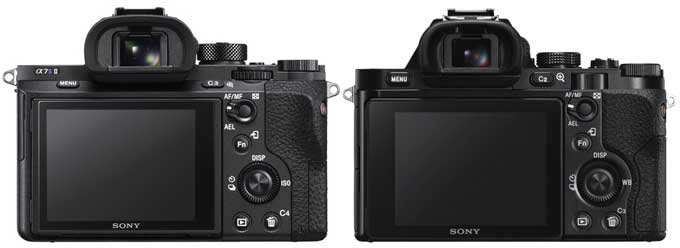
Sony A7SII can record 120fps at 100Mbps without pixel binning in full frame format also results in 4x/5x slow motion footage in Full HD. It has the ability to shoot 4x/5x slow motion footage internally.
Introduction of image stabilization: presence of 5-axis SteadyShot INSIDE image stabilization system in Sony A7SII makes it smooth shooting of stills and video by reducing five types of camera shake and it also it will give the option to the users to use any lens, or adapted lenses without facing any problems created by camera shake. But there is absent of such type of stabilization system in Sony A7S.
Rest of the core specification remains same.
Verdict: The Sony A7S II camera does have many upgrades over the Sony A7S camera but the sensor and image processor remains same. Finally the image quality of both the camera will be similar. For still shooters and owners of Sony A7S camera we don’t recommend to update you current camera against A7S II and you must wait for a better model, possibly the Sony A7S III with a new sensor and image processor.
Click here to see – Sony A7S vs Sony A7S II High ISO Test
Click here to see the Sony A7S II announcement page | Buy this Camera from B&H | Sony A7S II Sample Images
PS:
The biggest disappointment is the use of same sensor instead of developing a new one, Sony does have the capability to make Hybrid sensor as we already see in Sony A7R II camera. It’s better to say Sony updated the Sony A7S Camera, it’s not a new version
By abhishek, on September 6th, 2015
In the image below you can clearly see the difference between the resolution of Son A7R II and Sony A7S. The BSI CMOS Fullframe AF sensor of the Sony A7R II performing unexpectedly very well even at very High ISO range.
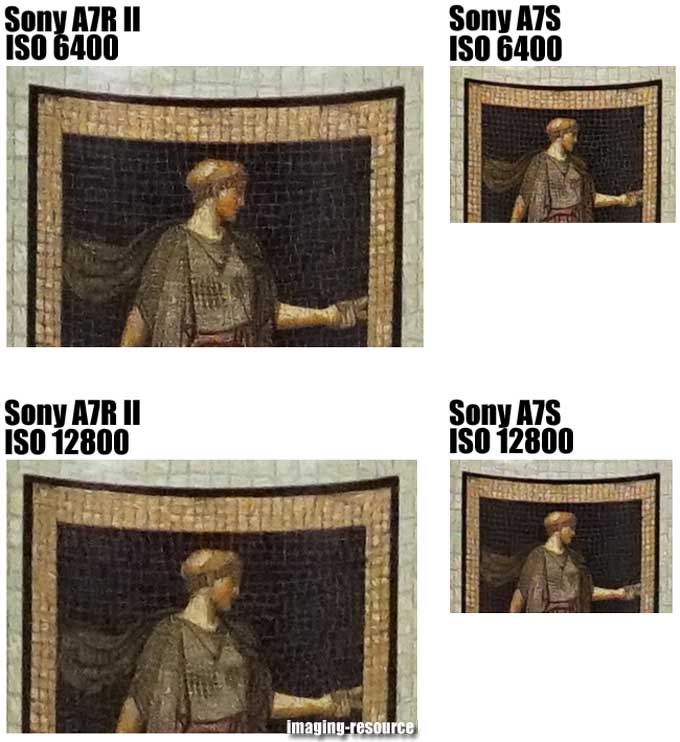 As I have said already the Sony A7R II not only giving us massive amount of details but the camera also features Hybrid AF and 5axis image stabilization, we highly recommend you to go with the Sony A7R II camera. As I have said already the Sony A7R II not only giving us massive amount of details but the camera also features Hybrid AF and 5axis image stabilization, we highly recommend you to go with the Sony A7R II camera.
Also see the post – Sony A7R II Showing More Details than Nikon D810
Also see – Best accessories for Sony A7R II | Sony A7R II available at Amazon and B&H
STAY WITH NEW CAMERA ON FACEBOOK | TWITTER | GOOGLE+
By abhishek, on August 30th, 2015
 This could be a serious competition between the two cameras one Olympus OM-D E-M10 II a complete newly born camera and its predecessor Olympus OM-D E-M10. This OM-D E-M10 II ‘s contribution is to extend the OM lineup and if we give a look at the specification table the major difference that we could see between the two is the implementation of 5-Axis image stabilization in the new one. However, this table shows nothing huge difference between the two as the same 16 mp resolution and the trade of same sensor. Both are having the low pass filter. Let’s talk the details of their differences. This could be a serious competition between the two cameras one Olympus OM-D E-M10 II a complete newly born camera and its predecessor Olympus OM-D E-M10. This OM-D E-M10 II ‘s contribution is to extend the OM lineup and if we give a look at the specification table the major difference that we could see between the two is the implementation of 5-Axis image stabilization in the new one. However, this table shows nothing huge difference between the two as the same 16 mp resolution and the trade of same sensor. Both are having the low pass filter. Let’s talk the details of their differences.
Major Difference
Olympus OM-D E-M10 II vs. Olympus OM-D E-M10 Specification Comparison Table.
| Features / Models |
Olympus M10 II |
Olympus E-M10 |
| Megapixel |
16 megapixels |
16 megapixels |
| Sensor size / type |
Four Thirds (17.3 x 13 mm) |
Four Thirds (17.3 x 13 mm) |
| Low-Pass-Filter |
Yes |
Yes |
| Image stabilization |
5axis |
3-axis |
| Image processor |
TruePic VII |
TruePic VII |
| AF System |
Contrast Detect (sensor) |
Contrast Detect (sensor) |
| AF points |
81 |
81 |
| ISO |
100-25600 |
200-25600 |
| Shutter Min/Max |
60 sec 1/16000 sec |
60 Sec 1/4000 sec |
| Top Continuous Shooting Speed |
8.5fps |
8fps |
| Video |
1920 x 1080 (30p), 1280 x 720 (30p) |
1920 x 1080 (30p), 1280 x 720 (60p, 30p) |
| Display |
3″ Rear Touchscreen Tilting LCD (1,040,000) |
Tiltable 3.0″ LCD touch screen, 1.04 million dots |
| Viewfinder |
EVF |
EVF |
| Hot-shoe |
Yes |
Yes |
| Wireless |
Built-In |
Built-In |
| Battery Life (CIPA) |
320 shots |
320 Shots |
| Dimensions |
120 x 83 x 47 mm |
119 x 82 x 46 mm |
| Weight |
390g |
396g |
Sensor: The sensor of both the camera is almost same and features same resolution. However the Olympus E-M10 II camera features better base ISO range compared to the E-M10 camera. The E-M10 II will sure give your better color and contrast output when image captured at ISO 100 vs ISO 200 of E-M10.
Image stabilization- Your shaky camera can’t harm your images anymore if you use OM-D E-M10 II because the engineering of 5-Axis IS help of which you will be delivered blur free images but on the other hand the old camera OM-D E-M10 has only 3-axis IS. So you could easily understand the difference.
Shutter speed- Want to capture the fast running train or any sports actions then your shutter speed 60 sec 1/16000 sec of OM-D E-M10 II on the other hand the OM-D E-M10 has only 60sec 1/4000sec.
Bit improvement in continuous shutter speed; The Olympus E-M10 II features 8.5 fps of continuous shooting speed on the other hand the E-M10 was limited to 8fps only.
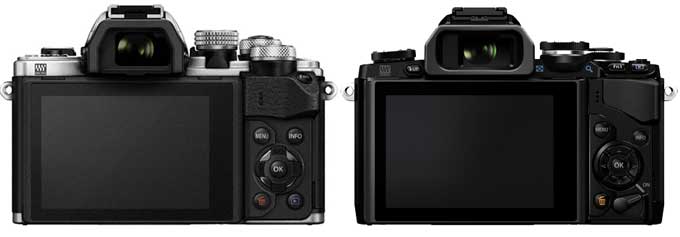
Display- The 3” OLED display of OM-D E-M10 II has the advantage that the color gamut is wider than that of an LCD display that allows more accurate reproduction of the colors of your images while these lacks are easily visible in LCD touchscreen of OM-D E-M10.
Video: It’s a big disappointment for all those who are expecting 4K in Olympus E-M10, however we have told you few months ago that the upcoming camera will not carry any improvement in the video section.
Verdict:
For current users The Olympus E-M10 did get incremental updates from Olympus but these updates are not enough for upgrading your E-M10 camera to E-M10 II.
However If you are a new entry level user and willing to buy a entry level mirrorless camera then Olympus E-M10 II is highly recommended for you.
Pre-order Olympus E-M10 from B&H
Pre-order Olympua E-M10 from Adorama
|
KEEP THIS BLOG ALIVE - Support New Camera Buy Canon Lenses, Buy Music CD or Digital Camera at amazon it helps this site, and you do not pay anything extra, it is just a way to help support this site.

|















